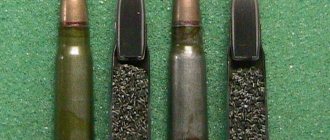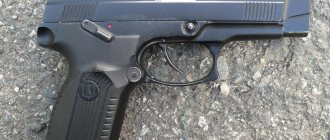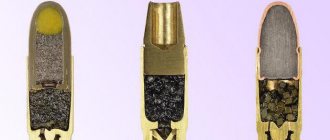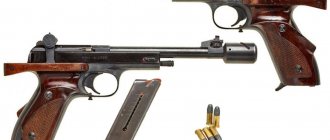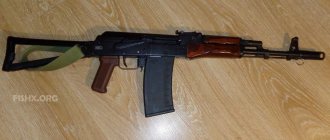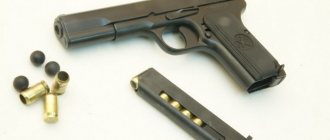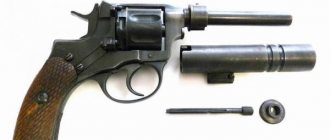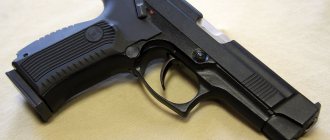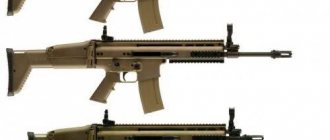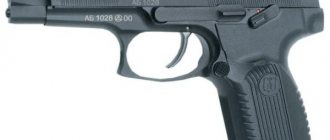The 9x18 PM cartridge was adopted by the Soviet army and law enforcement agencies in 1951. The ammunition came to replace the more powerful 7.62x25 TT, which had excessive bullet penetration and was poorly suited for use by the police. At the same time as the cartridge, they began producing a Makarov pistol for it.
Today, 9x18 mm PM is widely used throughout the world. In particular, it is used throughout the post-Soviet space and by a number of countries of the former Warsaw Pact. The ammunition continues to be regularly modernized to suit modern realities. For example, in 2005, the PPO (law enforcement cartridge) was adopted, which has low ricochetability and is produced by the Tula Arms Plant.
This ammunition is also actively used in all countries where the USSR supplied weapons. Licenses for full-fledged production were sold there. The same China continues to produce it in huge quantities for its own needs and for sale to other countries.
History of the creation of the 9x18 mm PM pistol cartridge
During the Great Patriotic War, the TT pistol received a lot of negative feedback from soldiers and officers. They complained about ergonomics, problems with safety cocking and strong recoil. Therefore, in the mid-1940s, the GAU initiated a competition to create a new cartridge-pistol complex to fully replace the Tula Tokarev.
Initially, they were developing two calibers at once: 7.65 mm and 9 mm. The last version was created at OKB-44. The designers, led by Semin, took the cartridge case from the 7.62 mm TT as a basis, but reduced the length to 18 mm. At the same time, they made it possible to integrate a 9 mm bullet. After all the tests, 9x18 PM cartridges were adopted by the Red Army and the police.
It is interesting that at the very beginning of development, the designers carefully studied common Western ammunition. In particular, 9x19 Para, .45 ACP and 7.62x17 Browning. After which they came to the conclusion that 9-mm ammunition would be the most relevant.
Due to the caliber and greater mass of the bullet, the kinetic energy of a shot from a PM was almost in no way inferior to that of a TT. At the same time, the muzzle energy of the Makarov pistol is significantly lower, which has a positive effect on the service life and manufacturability of the product.
Development of the first options ended in 1947. It was these samples that were put into production. They had a lead core bullet and a brass case. Full production began only in 1951 in Klimov at plant No. 711.
Despite the tests, the ammunition had several shortcomings and in 1953 the GAU commissioned NII-61 to develop an improved version. The designers were faced with the task of enhancing the penetrating ability of the cartridge. For these purposes, they changed the core to steel, the shell became lead. Changes affected the sleeve - now it has become bimetallic, steel. The cartridge, which passed all the tests, was put into production in 1955.
For some time, ammunition was produced in Lugansk, but later production was transferred to the Yuryuzan cartridge plant No. 38. It was produced there from 1955 to 1989. However, the development of the cartridge did not stop in 1955. Already in the late 70s, they launched production of modifications SP7 with increased stopping power and SP8 with PPS (reduced penetration ability). For the needs of the military and security forces, the RT 028 was developed, capable of penetrating light body armor.
In the Russian Federation, 9x18mm ammunition for PM is produced in very limited quantities. They mainly use old stocks, which are stored in huge quantities in warehouses. At the same time, pistol cartridges are regularly modified to suit the needs of the police and armed forces.
Chucks with reduced flange
.284 Winchester Comparison of the .50 GI reduced flange cartridge (left) with the .45 ACP (right) 5.56x45mm wafer cartridge compared to the .50 Beowulf cartridge (ammunition designed for use in modified AR-15 rifles)
( English Rebated rim). In such cartridges, the diameter of the rim is smaller than the diameter of the rest of the cartridge case. Functionally, they are similar to wafer-type ones. Such cartridges are developed with the goal of converting an existing weapon design into a larger caliber cartridge without changing the design of the combat cylinder.
An example of such a cartridge would be the .50 Action Express (or .50 AE), which is used in the Desert Eagle pistol for this caliber. To simplify production and reduce cost, the .50 AE cartridge was designed with a reduced rim that matches the rim diameter of the .44 Magnum cartridge for the existing Desert Eagle pistol. Therefore, the Desert Eagle can be converted from .44 Magnum to .50 AE by simply changing the barrel and magazine.
Other remanufactured cartridges, such as the short-lived .41 Action Express (rim diameter identical to the 9x19mm Parabellum) were used in the Jericho 941 pistol. Only the barrel had to be replaced for conversion. The latest were (early 2000s) the Winchester Short Magnum family of rifle cartridges, Winchester Super Short Magnum and Remington Ultra Magnum and Remington Short Action Ultra Magnum. In these cases, the rim was changed to fit the cartridge into the combat cylinder of existing magnum rifles. The case itself became wider to increase the charge, but the length remained the same to fit into the receiver.
The .50 Beowulf also uses a reduced rim design. This cartridge is used in AR-15 specialty rifles, and the rim size matches the rim size of the 7.62×39mm cartridge.
Also, similar cartridges are used in automatic guns, which originate from the 20-mm Becker gun, which belongs to the well-known Oerlikon family of anti-aircraft guns. Such guns use one of the advantages of projectiles with a reduced rim, namely the possibility of implementing a scheme with advanced piercing of the primer. In this case, the firing pin is broken and the primer is punctured before the bolt has reached the forward position and the projectile has been completely chambered. In this case, the recoil impulse is partially spent on damping the inertia of the bolt (equipped with a reinforced return spring), and thus reduces the recoil of the entire system, allowing the weight of the gun to be reduced and the use of a simplified locking device with a blowback bolt. Thanks to the reduced flange, the bolt cylinder goes inside the chamber channel, and the cartridge case evenly rests on its walls at the moment of ignition; In this way, safety requirements are also satisfied.
The designation of such cartridges includes the letters “RB”. For example, the cartridge for the above-mentioned Oerlikon Mk4 guns is designated 20x110mm RB.
- cartridge for Oerlikon Mk4 guns. The designation of such cartridges includes the letters “RB”.
How does the Makarov pistol cartridge (PM) work?
The ammunition was developed primarily for mass use by the army and law enforcement agencies. Therefore, the Makarov cartridge has a simple but reliable design. First of all, you should pay attention to the shape of the bullet - it is mushroom-shaped and pressed into a single block with a lead jacket and primer. The sleeve is bimetallic, has a cylindrical shape without flanges. The mass of the powder charge reaches 0.25 g, which allows not only to give the bullet an initial speed of 290 m/s, but also to ensure adequate travel of the bolt casing.
The main problem with the ammunition was its inability to penetrate metal. The bullet simply flattens upon impact and is likely to ricochet to the side. This effect was achieved due to the mushroom-shaped shape. The more specialized 9x18 cartridge is equipped with a bullet of a different shape: cone-shaped, truncated cone or open core. Different types of cartridges differ not only in the bullet, but also in the weight of gunpowder, weight, and lethal force varies.
There is an interesting story associated with the shape and caliber of the cartridge. The fact is that the GAU gave clear instructions to the designers that it was impossible to use ammunition in Western models of pistols and SMGs with a similar caliber. Moreover, Makarov also took into account the instruction that it was impossible to use another 9 mm cartridge in his pistol. In general, we did everything to reduce unification with NATO.
Description and characteristics of the cartridge
The 9x18-mm PM combat cartridge has the following tactical and technical characteristics.
| Total length of PM cartridge, mm | 24,8 |
| Exact bullet caliber, mm | 9,2 |
| Bullet weight, g | 3,7 – 6,1 |
| Cartridge weight, g | 7,4 – 10 |
| Bullet length, mm | Varies by type |
| Sleeve | Steel, bimetallic |
| Sleeve length, mm | 18,1 |
| Bullet diameter, mm | ~ 9 |
| Powder weight, g | 0,25 |
| Bullet flight speed, m/s | 315 – 500 |
| Effective range, m | 25 |
| Shot power, J | 300 – 505 |
Main characteristics
Since it is self-loading, all working mechanisms must be made of high quality weapon steel. All trigger parts are milled, which allows for a softer trigger stroke.
Almost all models have the same characteristics:
- Barrel length - 93 mm;
- The length of the pistol itself is 170 mm;
- Without a magazine, the weight of the weapon is 730 g;
- Shoots most comfortably at a distance of 7 m;
- When shooting at a live target - 3.5 m;
- Trigger force 15-35 N. Some cases record 75 N;
- Rate of fire up to 30 rounds per minute;
- Magazine capacity - 8 rounds;
- Working life - 5 thousand shots.
When firing, the diameter of the dispersion circle is 150 mm. The flight speed of a rubber bullet can reach 320 m/s. Which is not a weak indicator at all.
What types of cartridges are there?
Throughout its existence, Semin's pistol cartridge has been constantly refined. Based on the basic 9x18 mm ammunition, there are a number of specific cartridges that are used by various government and private structures. Each type has its own characteristics. Color marking helps determine the purpose of the cartridge. If the type of ammunition does not have a color designation, then the name can be found out from the letters and numbers stamped on the bottom of the cartridge case.
With a heavy lead core bullet
The first version of the standard 9 mm PM ammunition created. The design of the cartridge has changed quite a lot since then. To reduce costs, the material of the core and sleeve was changed to steel. In this case, the rod was inside the lead jacket. The cartridge was produced in this form from 1951 to 1955. It is now difficult to find and is found in private and museum collections. The GAU gave it the name 57-N-181.
With steel core
The 57-N-181S cartridge is a modified version of the ammunition. Features a steel mushroom core and a modified sleeve. For better retention, the bullet is pressed into a lead jacket. The key problem of 9 Pst is its weak penetration ability and high probability of rebound. The latter occurs due to the specific shape of the bullet. It was the 9 Pst that became the most popular 9 mm cartridge in the USSR.
With a tracer bullet
57-T-181 is a cartridge equipped with a chemical mixture that leaves a bright tracer behind the flying bullet. Another name for 9 PPT. Produced in Novosibirsk at the NVA plant. This ammunition is used for shooting at night.
With an expansive bullet
Closer to the 1970s, it was decided to improve the conventional 9 Pst and increase its stopping power. The main customer of the project was the KGB, since they needed to neutralize the target with minimal damage to others. The ammunition was designated SP7 and began entering service closer to the 1980s. The soft bullet had a notch and when it hit the target it was flattened, increasing the affected area. In addition, the initial flight speed increased to 420 m/s.
With a bullet of reduced penetration ability
In parallel with SP7, the development of a more specific SP8 ammunition was carried out. Its key feature was reduced penetration ability. This was ensured by the shape of the bullet and the materials from which it was made. The warhead was made from a mixture of plastic and lead. The main customer was the KGB. SP8 was used to storm airliners hijacked by terrorists. The bullet's penetrating power did not allow damage to the aircraft's fuselage and almost did not create ricochets.
With non-jacketed steel bullet
In the mid-1990s, Novosibirsk received an order to improve the standard 9x18 PM pistol cartridge. The main goal was, as always, to increase the bullet's penetration ability. For these purposes, the designers decided to change the standard shape of the ammunition. The cone-shaped part was truncated and when hit, the bullet did not pierce the shirt, but immediately hit the target. The core was made of hardened steel.
With a non-sheathed metal powder bullet
An interesting variant of 9 mm ammunition, whose warhead is not made of steel. The rod is entirely made of an alloy of several materials: lead, iron, manganese and zinc. When hitting a target, the bullet literally falls apart and provides a strong stopping effect. The cartridge is only suitable for defeating enemy personnel. When hitting harder objects, it does not harm them and does not ricochet. Of course, for targets equipped with body armor, such ammunition is not particularly dangerous.
With a light bullet type "THV"
The cartridge design was invented in France and is an expansive ammunition. The main feature was the presence of a cavity inside the cartridge, which significantly reduces the mass and increases the speed of the bullet. When firing, recoil is significantly reduced. It is mainly used by police officers. Unlike a regular bullet, the PM will almost certainly incapacitate the target upon impact.
With armor-piercing bullet PBM
7N25 or PBM is a Tula development in the field of increasing the armor penetration of the standard 9 mm PM cartridge. The product has greater muzzle energy when fired and, accordingly, increased flight speed. Unlike a conventional cartridge, the shirt is made of aluminum, and the tip is cut off. The steel rod protrudes slightly and is painted black. A 7N25 hit can penetrate light body armor at a distance of 30 meters.
New in blogs
The caliber for a rifled weapon is the internal diameter of the weapon's bore. Caliber can be measured in two main ways: by the fields of the rifling or by their valleys. The diameter of the bullet for a given barrel should be approximately equal to the caliber measured by the rifling lobes. In the former USSR and Russia, it is customary to measure the caliber by the rifling fields, and therefore the actual diameter of the bullets is larger than the indicated caliber.
Thus, the bullet diameter of the 9x18mm PM cartridge is 9.2mm, and that of the 7.62x39mm cartridge is 7.85mm. In most Western countries (USA, Europe), caliber is measured by rifling lobes, so, for example, the actual bullet diameter of a 9mm Parabellum cartridge is 9.02 mm.
In addition, there are 2 main measurement systems used in the world - metric, which is familiar to us, and the so-called imperial, where length (in relation to weapons) is measured in inches (1 inch = 25.4mm), weight in ounces (about 28 grams) and grains ( 0.068 grams). The imperial system is adopted in the UK and the USA, and in the USA the caliber is indicated in hundredths of an inch, and in the UK - in thousandths. In this case, the zero before the decimal point is not indicated. That is, the caliber designated in the USA as .45 is actually equal to 0.45 inches, or 11.43 mm, and the British caliber .303 is equal to 0.303 inches, or 7.7 mm. It should also be taken into account that the inch caliber designations are often arbitrary, for example, bullets of .38Sp and .357 Magnum caliber cartridges have the same diameter of 9.02mm, that is, approximately 0.355 inches.
We also note that many cartridges have something like their own names, which make it possible to unambiguously identify not only the caliber (bullet diameter) but also the type of cartridge. Examples of this are .45ACP, .38 Special, 9mm Luger/Parabellum cartridges and others. Designations like 9x18mm, 7.62x25mm are also often found. The first number in this entry indicates the caliber in millimeters, and the second number indicates the length of the sleeve (also in millimeters). Sometimes the letters “R” or “HR” are added to this designation. The first means that the sleeve has a protruding rim (rim (English), rand (German)), the second means the presence of a slightly protruding rim in combination with a groove (half-rim (English), halb-rand (German)). If the indicated designations are absent, this means that the cartridge case does not have a protruding rim, and the extractor hook catches the case by the groove at its bottom.
As a rule, revolver cartridges or cartridges developed in the late 19th - early 20th centuries have a case with a protruding rim, since the presence of a protruding rim complicates the creation of self-loading and automatic weapons.
SMALL CALIBER CARTRIDGES.
5.45x18mm PMZ.
In the late 1970s, the USSR developed and adopted the PSM pistol, created as a self-defense weapon for senior generals. The domestic cartridge differs from other small-caliber pistol cartridges (6.35mm Browning, aka 6.35x15mm or .25ACP, 5.6mm rimfire, aka .22LR) by a pointed jacketed bullet with a steel core and a bottle-shaped case. With a bullet mass of 2.4 grams, it develops an initial speed of 315 m/s with a muzzle energy of approximately 120 Joules. At short distances (up to 5-7 meters), this bullet, unlike the mentioned analogues, is capable of penetrating light body armor. In addition to the PSM pistol, which, by the way, is one of the flattest pistols in the world, the OTs-23 “Dart” pistol was recently developed for this cartridge. The pistol is intended for special operations, has quite impressive dimensions, a magazine with 24 rounds (versus 8 rounds in the PSM) and the ability to fire in bursts of 3 shots.
CARTRIDGES 7.62MM CALIBER
7.62x25mm TT (7.63mm Mauser, .30 Mauser)
The 7.63mm Mauser cartridge was created in 1896 for the Mauser C96 self-loading pistol, glorified by Russian films and books about the revolution and the Civil War. The cartridge is based on the design of the Borchard cartridge of the 1893 model (from the same cartridge the 7.62mm Luger / Parabellum cartridge grew, which later turned into the 9mm Para). The cartridge had significant power, when fired from the already mentioned Mauser, it penetrated 12 cm of pine board at a distance of 150 meters. A light (5.51 gram) bullet, ejected with a charge of 0.5 grams of smokeless powder, developed an initial speed of about 430 m/s with a muzzle energy of about 510 Joules. The significant power of this cartridge led to its great popularity throughout the world, and in 1930 in the USSR, a 7.62x25mm cartridge was created on its basis, and the differences in size with the 7.63 Mauser are so insignificant that the cartridges are often considered interchangeable. Such types of small arms as the TT pistol, PPD, PPSh, and PPS submachine guns are created and adopted for service in the Soviet Army with this cartridge. Due to the high velocity of the shell bullet, the cartridge still poses a serious threat to light body armor today.
Despite the fact that this cartridge was removed from the army’s arsenal back in the USSR, it continues to remain “in service”, although mostly on the “other side” of the law. It owes this not only to its excellent characteristics, but also to the presence of cheap clones of the Chinese-made TT pistol on the black market. In the West, this cartridge also has a certain popularity, again due to the presence of weapons in circulation, mainly of Soviet and Chinese origin.
9MM CALIBER CARTRIDGES
9x17mm Browning Short (.380 Auto, 9mm Browning Kurz/Korto/Short)
The world-famous gunsmith John Moses Browning created this cartridge for the American company Colt in 1908 based on the 9mm Browning Long cartridge of his own design, created for the Belgian company FN in 1903. In the USA, this cartridge appeared under the designation .380 ACP. In 1910, the Belgian company Fabrique Nationale (FN) also began producing Browning-designed weapons chambered for this cartridge, designating it the 9mm Browning Short. Between the First and Second World Wars, this cartridge gained popularity on both continents as police and civilian ammunition in such models as the FN-Browning pistols model 1910 and 1922, Colt "pocket model". Later, such pistols as Walter PP, Mauser HSC (HSc), Colt “Mustang” and “Officer Model”, FN Model 140 and many others were produced for this ammunition.
This cartridge is certified in Russia as a service cartridge, and a modification of the PM pistol under the designation IZH-71 and a number of other pistols and revolvers are produced for it. For the 9x17mm cartridge, the following characteristics are typical: bullet mass 6.2 grams, muzzle velocity - about 260 m/s, muzzle energy - about 220 Joules.
9x18mm Makarov.
The history of this cartridge is quite widely known. In 1945, the USSR decided to develop a new self-defense weapon for officers of the Soviet Army. In 1951, the Soviet Army adopted a 9mm Makarov system pistol and a 9x18mm cartridge for it. This cartridge was developed, obviously, not without regard to the 9mm Ultra (9×18 Ultra) cartridge developed in Germany in 1936. This cartridge was created for the Walter PP pistol as an intermediate in power between the 9mm Browning short cartridges (9mm Kurz/Short, in our country known as 9x17mm service ammunition) and 9mm Parabellum.
Despite the same names, the 9x18 Makarov and 9x18 Ultra cartridges are not interchangeable, since they have different bullet diameters. Most Western-made 9mm cartridges (9x17, 9mm Para, .38Sp, .357 Magnum) have a bullet diameter of 9.02mm, while the 9x18PM cartridge has a bullet diameter of 9.2mm. This is explained by the fact that in the West the caliber is measured by the bottom of the rifling, and in the territory of the former USSR - by the fields of the rifling. Initially, the 9x18PM cartridge had a jacketed bullet with a lead core, later it acquired a bullet with a steel core and a lead jacket under a metal jacket. In recent years, this cartridge began to be produced in a version with a semi-jacketed expansive bullet, in the 9x18 PBM version with a bullet of increased penetration.
There are widely known attempts to extend the military life of this cartridge by creating a variant of the 9x18PMM cartridge, which could be called 9x18PM +P+ in a Western manner. The standard 9x18PM cartridge has a bullet weighing 6.1 grams, an initial velocity (when fired from a PM pistol) of about 315 m/s and a muzzle energy of about 300 Joules. The 9x18PMM cartridge has a bullet weighing 5.54 grams, an initial velocity of about 420 m/s and a muzzle energy of about 420 Joules. As with other modified high-power ammunition, the 9x18PMM cartridge can only be used in weapons specifically designed for it.
It should be noted that both the 9x18PM cartridge and the Makarov pistol have well-deserved popularity not only in the territory of the ex-USSR, but also in the West, including the USA. The presence in Western markets of a significant number of PM pistols of Soviet, East German, Bulgarian production, their Czech and Hungarian analogues, at low prices and high quality weapons, are the main reasons for this. The Western market is saturated not only with domestically produced cartridges - many Western, including American, companies produce 9x18PM cartridges equipped with various bullets - semi-jacketed bullets of various designs, shelled, expansive, and so on.
9mm Luger / Para[bellum] (9x19mm, 9mm NATO)
The 9mm Parabellum cartridge, better known on the North American continent under the name of its creator - Georg Luger, as well as under the designation 9mm NATO pistol cartridge - is the only cartridge that in less than 100 years of its life has deserved to be called simply “9mm cartridge”. Georg Luger created this cartridge when the Kaiser's German Navy expressed interest in the Parabellum pistol of his design, but considered its original 7.62mm caliber insufficient. In 1902, Luger changed the shape of the cartridge case from a bottle to a cylindrical one, and in 1904 the German Navy, followed by the German Army in 1908, adopted the Luger pistol and its cartridge.
Initially, the cartridge had a shell bullet with a head in the form of a truncated cone. Later, with the adoption of automatic weapons, the cartridge acquired an ogive-shaped jacketed bullet. Cartridges produced for civilian and police weapons were equipped with almost all types of bullets produced in the world.
This cartridge became most widespread in Europe, and since 1985 - in the USA, when the US Army adopted the 9mm Beretta 92 pistol under the designation M9. This event led to the rapid spread of the cartridge and weapons for it on the US market. Recently, this cartridge is being seriously prepared to take on the last major world bastion - Russia is seriously considering the possibility of adopting a new 9x19mm cartridge, which is a modernization of the 9mm Parabellum cartridge, into service with the Russian Army.
9mm cartridges have several modifications that differ in power: 9mm, 9mm +P, 9mm +P+ and 9mm NATO. The designations +P and +P+ indicate “increased barrel pressure” and “very high barrel pressure,” respectively. The characteristics of 9mm NATO cartridges are close to 9mm +P+ cartridges. Using this type of ammunition in a weapon designed to chamber standard 9mm cartridges, such as the older Luger P-08 or Walter P-38, can cause the weapon to fail. The standard 9mm NATO cartridge has a bullet weight of 7.82 grams at a muzzle velocity of 390-400 m/s or 8.43 grams at a muzzle velocity of about 375 m/s. Muzzle energy is about 600 Joules. Standard 9mm Luger/Parabellum cartridges, or more precisely, cartridges with standard barrel pressure, have a bullet weight of 6 to 10.7 grams, an initial velocity of 300 to 450 m/s, and muzzle energy of 450 to 550-600 Joules.
9x21mm IMI
This cartridge was developed in the mid-1980s and its ballistic characteristics are almost equivalent to the 9x19 Para cartridge. This cartridge owes its origin to the fact that in some countries (for example, Italy) only those cartridges that are not in service in these countries are allowed for civilian circulation. Accordingly, this cartridge is produced mainly in Europe.
Typical characteristics: bullet weight 7.82 or 8.43 grams, initial speed - 350-360 m/s, muzzle energy - 500-530 Joules. In particular, many Beretta pistols intended for the European civilian market are produced under this cartridge (Beretta 92, Beretta 8000 Cougar, Beretta 9000).
9x21mm SP-10
Domestic cartridge for special purposes. Sometimes the developer index (TsNIITochMash) - RG052 is used to designate it. The cartridge was created for the Vector pistol (also known under the export name “Gyurza” - not to be confused with the Vector pistols of the same name produced in South Africa) and is intended to combat targets protected by body armor or obstacles such as a car body. Unlike foreign functional analogues (cartridges .357magnum, .357SIG, 10mm auto), this cartridge uses not only increased bullet speed to increase penetration ability, but also a specially designed bullet with a high-strength tungsten carbide core partially exposed in the nose. Bullets of a similar design are used in the 9x18mm PBM pistol cartridge.
The cartridge provides reliable penetration of class IIIA body armor according to the American classification, providing protection from cartridges up to .44 magnum inclusive, at ranges over 50 meters. Currently, this cartridge and the Vector pistol (under the designation SR-1) have been adopted by some domestic special services. The SP-10 cartridge has the following characteristics: bullet mass - 6.7 grams, initial speed - 420 m/s, muzzle energy - 590 Joules.
9mm Largo (9x23mm, 9mm Bergman/Bayard)
Along with the 9mm Para cartridge, it is one of the oldest European military cartridges. In 1903, this cartridge was first used in an automatic pistol of the Bergmann system. The pistol was produced by the Belgian company Piper under the Bayard brand, which determined one of the names of the cartridge. This pistol was adopted by the Danish army in 1910, but the 9mm Largo cartridge gained real popularity thanks to Spanish weapons. Since 1913, the Spanish (Unceta y Compania Astra), "Star" (Bonifacio Echeverria Star), Llama and a number of others have produced (and are still producing) a significant number of pistols (and even submachine guns) chambered for this cartridge. The "Largo" designation in the cartridge name is just the word for "large" in Spanish, similar to, for example, the name of the 9mm Browning Long cartridge (not discussed here).
Typical characteristics of the cartridge are bullet weight 8-9 grams, muzzle velocity - 360-370 m/s, muzzle energy - about 550-570 Joules.
It should be noted that in 1996, the American company Winchester announced a new cartridge, declared as an excellent replacement for the old .38 super auto. The new cartridge is called 9x23mm Winchester and is practically the same in size as the 9mm Largo cartridge. The main difference is that the 9mm Winchester has thicker case walls than the 9mm Largo, which makes it possible to increase the muzzle velocity to 380-400 m/s. Not a great achievement, considering that most 9mm Largo pistols were created 40 or more years ago, when the maximum permissible pressures in the barrel were much lower (over the years, metallurgy and technology have made significant strides forward).
.357 SIG (9x22mm pistol)
In the early 1990s, this cartridge was produced by re-compressing the barrel of a .40SW cartridge to accommodate a 9mm caliber bullet. With this modification, the creators of the cartridge achieved the following results: more reliable chambering of cartridges, since the diameter of the bullet turned out to be noticeably smaller than the diameter of the rear part of the chamber, which eliminated the possibility of sticking the cartridge when feeding; an increase in the muzzle velocity compared to both the original .40SW cartridge and the 9mm Para cartridge, which gave a flatter firing trajectory and greater penetrating power; the possibility of using this cartridge in existing .40SW pistols after simply replacing the barrel, and possibly the recoil spring.
The recoil of the new cartridge turned out to be quite moderate, while the increase in initial speed was quite significant. With a bullet weighing 6.12 grams (as in the 9x18PM cartridge), the initial velocity when firing from a weapon with a 100mm barrel can reach values of 460 and even 520 meters per second, which gives muzzle energy values of 650-820 Joules, that is, 2- 3 times higher than PM and close to .357 Magnum. With a bullet weighing 7.82 grams, the initial speed can reach 450-460 m/s, with a bullet weighing 10 grams - 360 m/s. Obviously, the first to release pistols chambered for this cartridge were its creators, more precisely, the German-Swiss company SIG-Sauer. Pistols from this and other well-known companies, originally created for the .40SW cartridge and equipped with barrels chambered for the new cartridge (SIG-Sauer P226, P229, Glock model 31, Heckler-Koch USP), very quickly gained popularity in the American market.
In addition to a significant number of police departments that appreciated the possibility of combining the power of the .357 Magnum cartridge with the reliability and high-capacity magazines of modern self-loading pistols, this cartridge was adopted by the US Secret Service (in particular, they protect the US President).
38 Super (9×23mm HR)
The .38 Super cartridge is a “reinforced” version of the rather old (created in 1900) .38 Colt auto cartridge. In 1929, Colt significantly strengthened the powder charge of its .38 auto cartridge, and in order to avoid confusion and fatal errors associated with equipping old pistols with new cartridges, as well as for marketing reasons, added the word “Super” to the name (designations of the type +P and +P+ did not yet exist in 1929). This cartridge was used mainly in Colt pistols, created on the basis of the “eternal” Browning design, first embodied in the M1911 .45 caliber model. Compared to similar pistols of .45ACP caliber, pistols chambered for .38 Super had noticeably lower recoil, a larger magazine capacity (usually 9 rounds instead of 7) and slightly lower shooting accuracy.
This was the case until 1988, when Colt changed the pattern of cartridge positioning in the chamber of its pistols (the cartridge began to be fixed along the leading edge of the cartridge case, and not along the weak rim of the cartridge case, as had been done for the previous 59 years). All this time, the .38 Super cartridge remained in the shadow of its competitors, the main one being the 9mm Luger/Parabellum. However, after 1988, weapons for this ammunition began to gain popularity among athletes shooting according to the rules of the USPSA (United States Pistol Shooting Association) and IPSC (International Practical Shooting Association). Due to the larger volume of the cartridge case, .38 Super cartridges are somewhat superior in characteristics (velocity, muzzle energy) to 9mm Para cartridges, however, due to the greater length of the cartridge case, they are practically not used in compact and subcompact pistols.
Until now, the main type of weapon using .38 super cartridges remains various variations on the M1911 theme, both from Colt and from other manufacturers. Of the other Western cartridges, the .357 SIG cartridge can be considered the closest to the .38 Super in terms of characteristics. For .38 super cartridges, the following parameters are typical: bullet mass - 7.82 or 8.43 grams, muzzle velocity - approximately 430-420 m/s, muzzle energy - approximately 730-750 Joules.
38 Smith & Wesson Special (9x29mm R; rimmed revolver)
The .38 Special cartridge, or .38Sp, along with the .45ACP and 9mm Para cartridges, is one of the oldest military cartridges. Smith & Wesson introduced it in 1902 as ammunition for its new Military and Poplice Model revolver. Over the years, the M&P revolver evolved into the Model 15 "Combat Mastrepiece", one of the most popular police revolvers in the United States. At the end of the 1970s, the .38Sp + P ammunition was born, which was the same cartridge, but with a larger charge of gunpowder and a slightly lighter bullet.
As with 9mm Para cartridges, such cartridges can only be used in weapons designed for them. Older models created for the “classic” .38Sp cartridge may suffer from the use of high-power ammunition in them. The .38Sp cartridge is widely used as ammunition for compact revolvers, including police and army ones. Until recently, Smith-Wesson .38Sp revolvers were in service with the US Air Force, and only recently they began to be replaced by M10 pistols (SIG-Sauer P228) in 9mm Para caliber.
.357 Smith & Wesson Magnum (9x32mm R; rimmed revolver)
The .357 Magnum cartridge was introduced to the US arms market in 1935 by Smith and Wesson. The cartridge was created as an improved ammunition for police, designed to replace the good old .38 Special, developed by the same company about thirty years earlier. Despite the difference in designation, the calibers of both cartridges are equal (bullet diameter 9.02 mm), but the .357 Magnum cartridge case is 3.43 mm longer, so this cartridge cannot be loaded into revolvers chambered for the .38 Special cartridge. By increasing the volume of the cartridge case, the charge of gunpowder was also increased. As a result of the changes, the characteristics of the new cartridge have increased significantly: The .38 Sp cartridge of factory equipment with a bullet weighing 10.74 grams gives it an initial speed of about 230 m/s with a muzzle energy of about 270 Joules, while the .357 Magnum cartridge with a bullet of the same weight accelerates the bullet to 370-380 m/s with a muzzle energy of about 730 Joules. With lighter bullets, the initial velocity can reach 430 m/s with a muzzle energy of about 800 Joules.
The introduction of the .357 coincided with Prohibition, so photos of police officers shooting through car doors were often used to advertise the new ammunition. During the 1950s, the .357 Magnum was the standard caliber for many police departments throughout the United States. Around the same time, it began to gain popularity as a hunting ammunition. Currently, almost all revolver manufacturers in the world produce weapons for this caliber. In addition, despite the enormous popularity of automatic pistols, many police officers in the United States still trust their lives to .357 Magnum revolvers. The main disadvantage of this cartridge as a combat cartridge is its significant recoil, with the exception of its use in “monster” pistols like the Desert Eagle or in carbines.
10MM CALIBER CARTRIDGES
.40 Smith & Wesson (10x22mm)
One of the newest players in the field of police and self-defense ammunition, the .40 Smith & Wesson cartridge was announced in 1990. Over the next 5 years, it became the “holy grail” of American law enforcement. The .40S&W cartridge was born out of the FBI's choice of 10mm for a new generation of sidearms. But the 10mm “auto” cartridge, created at the request of the FBI, turned out to be too “hot” - excessive recoil seriously hampered targeted shooting. The FBI lowered its requirements for the cartridge, reducing the desired bullet weight from 13.6 to 12.24 grams and the muzzle velocity from 366 to 300 meters per second. The result was a cartridge close in characteristics to the legendary .45ACP, and its only advantage was a slight reduction in the diameter of the case. Smith-Wesson designers reduced the length of the cartridge case from 25.2 to 21.6 millimeters, maintaining the original bullet weighing 12.24 grams. The result is a new cartridge that has firmly taken its place between the two “kings” - the European 9mm Luger/Parabellum and the American .45ACP.
Almost all world arms manufacturers (including Russian ones) currently produce pistols chambered for this cartridge. It is adopted by the FBI, the US Secret Service and many police departments throughout the United States. Based on it, the Swiss concern SIG created a new cartridge - .357SIG (9x22mm), which is also gaining wide recognition. The most widely used .40SV caliber cartridges with a bullet weighing 12.24 grams provide muzzle velocities from 305 to 360 meters per second and energy from 560 to 790 Joules. The FBI equips its employees with .40-caliber Glock pistols and cartridges with a HydraShok bullet weighing 11.22 grams with a muzzle velocity of about 300 m/s. The US Drug Enforcement Agency equips its employees with pistols from various manufacturers (Glock, Heckler-Koch USP, SIG-Sauer P229) and cartridges with a Remington Golden Saber bullet weighing also 11.22 grams and an initial speed of about 350 m/s.
10mm Auto (10x25mm)
The 10mm Auto cartridge was created in the early 1980s in the USA and was first introduced to the general public in 1983. Initially, the Bren Ten pistol from Dornaus & Dixion was created for this powerful cartridge, but this pistol was never really able to enter the arms market. The 10mm auto cartridge remained afloat only thanks to the efforts of the Colt company, which appreciated the potential of this ammunition and released a modification of the classic Colt M1911 chambered for this cartridge. Initially, 10mm auto cartridges were equipped with a bullet weighing 13.6 grams with an initial speed of about 360 m/s or a bullet weighing 11.56 grams with an initial speed of about 430 m/s. Currently, these cartridges are loaded with bullets weighing from 9.18 to 14.28 grams. Due to the significant barrel pressure and high recoil, this cartridge can be used primarily in full-size, massive pistols such as the Colt Delta Elite or Glock Model 20.
Due to its good performance when shooting at protected targets (through thin walls, car doors), the cartridge was adopted by the FBI, as well as some police departments throughout the United States. In addition to pistols, a number of world-famous MP-5 submachine guns under the designation MP-5/10 were produced for it. As far as I know, most (if not all) of these submachine guns entered service with the US FBI. Based on the 10mm auto cartridge, several other cartridges of a smaller caliber were created by compressing the case neck, including 9x25mm and .224BOZ (the latter is a combination of a modified 10mm auto case and a bullet from the 5.56mm NATO cartridge). Currently, the following characteristics can be considered typical for this cartridge: bullet mass 10.5 grams, muzzle velocity (from a pistol barrel) - about 370 m/s, muzzle energy - about 700 Joules.
CARTRIDGES OF CALIBER OVER 10MM
.41 Remington Magnum (10.4×33mm R rimmed revolver)
The .41 Remington Magnum cartridge is more commonly referred to simply as the .41 Magnum. It appeared in 1964 through the efforts of Remington, as the name suggests, and was first used in the Smith & Wesson Model 57 revolvers. It was created for police officers who wanted a cartridge more powerful than the good old .357 Magnum, but more comfortable (with less recoil and muzzle flash) than the .44 magnum.
Despite the fact that this cartridge was adopted by many police departments in the United States, it never became widespread. With a bullet weighing 12.3 grams, having a muzzle velocity of 395 m/s and an energy of about 1000-1100 Joules, the recoil and muzzle flash were excessive for most shooters. Currently, it is used mainly for hunting medium game.
.44 Magnum (11.18×33mm R rimmed revolver)
The .44 Magnum cartridge has never been used in combat. However, thanks to Hollywood and Dirty Harry personally (played by Clint Eastwood), many consider this cartridge to be a combat cartridge. However, even in the Dirty Harry series itself, he ran around with a .41 magnum caliber revolver (also not a combat one). This cartridge was created in 1955 by the famous American shooter and gunsmith Elmer Keith in collaboration with Smith-Wesson and is intended primarily for hunting.
Initially, the Smith-Wesson M29 revolver was created for it, and then variants of Winchester shotguns with a Henry bracket were created. This cartridge, like most revolver cartridges, has a rimmed case. However, there are a number of pistols capable of using this cartridge, including the famous Desert Eagle. A typical .44 magnum cartridge with a 16.2 gram bullet has a muzzle velocity of about 360 m/s and an energy of about 1000 Joules. With a bullet weighing 12.24 grams, the initial speed can reach 450 m/s, but the recoil and sound of the shot become difficult to bear, and the muzzle flash is not inferior to an artillery shot.
.45ACP (Automatic Colt Pistole - Colt Automatic Pistol, 11.43x23mm)
The grandfather of American pistol cartridges - this is exactly what this cartridge is called by the American magazine Guns&Ammo. This cartridge was created by John Moses Browning specifically for his 1905 model self-loading pistol, which became the prototype for one of the most popular pistols in America, the Colt-Browning M1911.
This cartridge arose from the US Army's dissatisfaction with the .38 caliber (9mm) Model 1889 revolver cartridge in service. The Army wanted a cartridge comparable in power to the .45 Colt revolver cartridge used at the end of the Indian Wars. Since its introduction, the .45ACP cartridge gained enormous popularity in the United States and remained the standard pistol ammunition of the US Army and law enforcement forces until 1985, when the US Army adopted the Beretta 92 pistol and the 9mm Luger/Parabellum cartridge under the designation M9.
The main secret of the popularity of the .45ACP cartridge is a heavy (12.58 grams or more) bullet with a relatively weak powder charge. As a result, the bullet of this cartridge has a relatively low speed with high accuracy and significant stopping effect. Despite the emergence of newer ammunition, the .45ACP cartridge is still one of the most popular in the United States, including in the police. In addition, in 1994, the US Army adopted the Mk.23 pistol from the German company Heckler and Koch of the same .45ACP caliber for its Special Operations forces. The standard .45ACP cartridge has an ogive-shaped jacketed bullet with a lead core. Bullet mass - 15.64 grams, initial speed - 260 m/s, muzzle energy - about 500 J.
45 Colt (11.43x33mm R revolver)
The .45 Colt cartridge was created in 1873 for use in the US Army New Model 1873 Single Action revolver, better known as the Single Action army or Peacemaker. The design of both the revolver and the cartridge were almost entirely the product of the US Army Cavalry and Horse Artillery, and remained in military service until they were replaced by the less powerful, but more comfortable to shoot .38 Colt cartridge and the Model 1889 double-action revolver.
After its official “discharge from service”, this cartridge was “called up from reserve” twice more - the first time during the invasion of the Philippines, the second in 1909, when it became clear that the adoption of the new .45 caliber automatic pistol was delayed. Much later, in the 1970s and 80s, Smith & Wesson created the Model 25 revolver for this cartridge, which was quite popular among police officers who wanted a revolver with a heavier bullet than the .38 Special or .357 Magnum cartridges.
Currently in the United States, this cartridge remains quite popular as a hunting ammunition and as a cartridge for recreational shooting in the “cowboy” style. A typical .45 Colt cartridge has a lead non-jacketed bullet weighing 17.3 grams. The initial bullet speed is about 260 m/s, the muzzle energy is about 570 Joules.
Ammunition for PMM
At the end of the 80s of the last century, an army competition began to replace the outdated PM. The participants of the Grach program were contacted with the following requirements:
- The new pistol was supposed to penetrate standard body armor at a distance of 100 m;
- The design must use the most modern materials;
- Improving the overall ergonomics of weapons;
- High technology of products and the possibility of mass production.
At the same time, they were developing several pistols at once. In some cases, they even developed a new pistol-bullet complex (SR-1 and 9x21 mm cartridge). At the same time, an attempt was made to modernize the conventional Makarov Pistol. The project was carried out by designers from the Tula Arms Plant.
To increase penetrating power, the size of the powder charge was increased by 30 percent. The shape of the bullet was changed. As a result, the resulting cartridge received the marking 9x18 PMM or 57-N-181-SM. By increasing the muzzle energy, the bullet became capable of penetrating 1st generation army body armor or hitting a target behind thin cover. For this we had to pay with increased recoil and weight of the weapon.
The most interesting thing is that the standard pistol was not capable of firing this ammunition. Such a cartridge in the PM chamber rendered the product unusable over time. At the same time, a situation with a rupture of the chamber arose and often occurred. To neutralize the negative effect, the PMM Modernized Makarov Pistol was created. The model's barrel and some of the internal mechanisms were strengthened, but this led to an increase in weight and deterioration in ergonomics. Nowadays PMM is rarely used.
